![17 Top Internal Communication Channels [Infographic] · CMBell](https://img.oercommons.org/160x134/microsite-wi-prod/media/screenshots/a3a04295da22dc3f87a4f3ed67bd02b56bd42d03639bc0f353fc382d5169218f.png)
Infographic explains various internal communication channels and how to use them
- Subject:
- Career and Technical Education
- Material Type:
- Reading
- Reference Material
- Author:
- Delona Bell
- Date Added:
- 05/22/2018
![17 Top Internal Communication Channels [Infographic] · CMBell](https://img.oercommons.org/160x134/microsite-wi-prod/media/screenshots/a3a04295da22dc3f87a4f3ed67bd02b56bd42d03639bc0f353fc382d5169218f.png)
Infographic explains various internal communication channels and how to use them
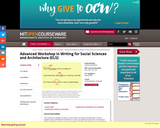
Advanced subject focusing on techniques, format, and prose style used in academic and professional life. Emphasis on writing as required in fields such as economics, political science, and architecture. Short assignments include: business letters, memos, and proposals that lead toward a written term project. Methods designed to deal with the special problems of those whose first language is not English. Successful completion satisfies Phase II of the Writing Requirement. This workshop is designed to help you write clearly, accurately and effectively in both an academic and a professional environment. In class, we analyze various forms of writing and address problems common to advanced speakers of English. We will often read one another's work.
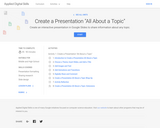
This 45-90 minute Google Applied Digital Skills lesson includes videos, lesson plans, and rubric. It is appropriate for middle school and high school students. It teaches transitions and animation along with collaboration.
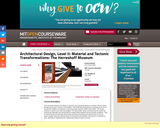
This semester students are asked to transform the Hereshoff Museum in Bristol, Rhode Island, through processes of erasure and addition. Hereshoff Manufacturing was recognized as one of the premier builders of America's Cup racing boats between 1890's and 1930's. The studio however, is about more then the program. It is about land, water, and wind and the search for expressing materially and tectonically the relationships between these principle conditions. That is, where the land is primarily about stasis (docking, anchoring and referencing our locus), water's fluidity holds the latent promise of movement and freedom. Movement is activated by wind, allowing for negotiating the relationship between water and land.
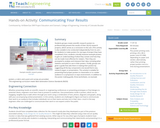
Students groups create scientific research posters to professionally present the results of their AQ-IQ research projects, which serves as a conclusion to the unit. (This activity is also suitable to be conducted independently from its unit—for students to make posters for any type of project they have completed.) First, students critically examine example posters to gain an understanding of what they contain and how they can be made most effective for viewers. Then they are prompted to analyze and interpret their data, including what statistics and plots to use in their posters. Finally, groups are given a guide that aids them in making their posters by suggesting all the key components one would find in any research paper or presentation. This activity is suitable for presenting final project posters to classmates or to a wider audience in a symposium or expo environment. In addition to the poster-making guide, three worksheets, six example posters, a rubric and a post-unit survey are provided.
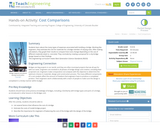
Students learn about the many types of expenses associated with building a bridge. Working like engineers, they estimate the cost for materials for a bridge member of varying sizes. After making calculations, they graph their results to compare how costs change depending on the use of different materials (steel vs. concrete). They conclude by creating a proposal for a city bridge design based on their findings.
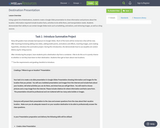
Using a given list of destinations, students create a Google Slide presentation to show information and pictures about the location. Information required include location facts, activities to do while there, and transportation needs. Students demonstrate their ability to use certain Google Slides tools such as bulletting, animations, and retrieving images, as well as citing sources.
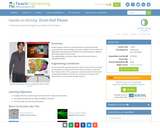
Student teams commit to a final decision on the location they recommend for safe underground cavern shelter for the citizens of Alabraska. They prepare and deliver final presentations to defend their final decisions to the class.
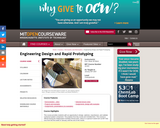
This course provides students with an opportunity to conceive, design and implement a product, using rapid prototyping methods and computer-aid tools. The first of two phases challenges each student team to meet a set of design requirements and constraints for a structural component. A course of iteration, fabrication, and validation completes this manual design cycle. During the second phase, each team conducts design optimization using structural analysis software, with their phase one prototype as a baseline.

This resource is a link to slides of a presentation titled "Esports - A Good fit for Librarians", offered by Shelly Napier, District Librarian for the Slinger School District in Wisconsin, at the Wisconsin Educational Media & Technology Association (WEMTA) annual conference 2024.
Shelly shared outstanding and inspirational info about her journey of going from a "total newbie" in the Esports world to developing a wildly successful and popular (officially recognized) Esports team at her school, reaching new students who hadn't necessarily found their "group" prior.
To contact Shelly directly, you can email her at: shelly.napier@slingerschools.org

This lesson plan can be connected to a career-ready path, as it focuses on important concepts related to biodiversity and the impact of human activities on it. Students who are interested in pursuing careers in biology, environmental science, ecology, conservation, or other related fields would benefit from gaining knowledge and skills related to biodiversity. Additionally, the research skills, critical thinking, and problem-solving skills that students will develop in this lesson can be applied to a variety of careers. For example, individuals who work in conservation or environmental science may need to evaluate the impact of human activities on biodiversity and design solutions to mitigate negative effects. Overall, this lesson plan can help students gain valuable knowledge and skills that are relevant to a wide range of careers in the STEM fields.
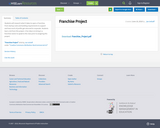
Students will research what it takes to open a Franchise. From startup costs and building requirements to support and how much of profits get returned to corporate. Students learn a lot from this project. A fun idea is to bring in a franchise owner to speak to the class prior to assigning this project.
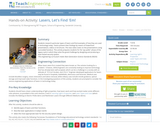
Students research particular types of lasers and find examples of how they are used in technology today. Teams present their findings by means of PowerPoint presentations, videos or brochures. The class takes notes on the presentations using a provided handout. This activity prepares students for the "go public" phase of the legacy cycle in which they solve the grand challenge by designing and producing a laser-based security system.
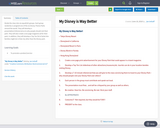
Divide the class into six equal(ish) groups. Each group randomly is assigned one of the six Disney Theme Parks around the world. They will develop a presentation/infomercial as to why people should visit their park. They will also create a one page magazine ad for their park. In addition, they will develop a Top Ten list of what else families might do in that city other than the Disney park.

Deals with more advanced design theories and textual analysis. Emphasis on script analysis in general, as well as from a designer's perspective. Students also refine technical skills in rendering and presentation, historical research, and analysis. Class sessions include interaction with student/faculty directors and other staff designers. Goal is for students to approach text with a fresh vision and translate that vision into design for performance.
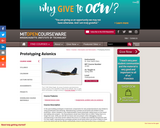
In the past building prototypes of electronic components for new projects/products was limited to using protoboards and wirewrap. Manufacturing a printed-circuit-board was limited to final production, where mistakes in the implementation meant physically cutting traces on the board and adding wire jumpers - the final products would have these fixes on them! Today that is no longer the case, while you will still cut traces and use jumpers when debugging a board, manufacturing a new final version without the errors is a simple and relatively inexpensive task. For that matter, manufacturing a prototype printed circuit board which you know is likely to have errors but which will get the design substantially closer to the final product than a protoboard setup is not only possible, but desirable. In this class, you'll learn to design, build, and debug printed-circuit-boards.

Working collaboratively students pick a company to research to learn more about the history and success of the organization. The group needs to find the following pieces of information:
Company NameList of Products ProducedCompany HistoryCompany Future Outlook/Current Company NewsProduct AdvertisementsProfit/Loss Information (listed and compared to another company)CEO and Other Important Figures ListedCurrent Stock Price (graph)Five Other Pieces of Pertinent Information
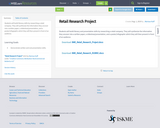
Students will build literacy skills by researching a retail company. They will synthesize the information they uncover into a written paper, a slideshow/presentation, and a poster/infographic which they will then present in front of an audience.
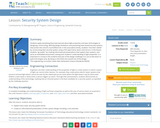
Students apply everything they have learned about light properties and laser technologies to designing, constructing and presenting laser-based security systems that protect the school's mummified troll. In the associated activity, students "test their mettle" by constructing their security system using a PVC pipe frame, lasers and mirrors. In the lesson, students "go public" by creating informational presentations that explain their systems, and serve as embedded assessment, testing each student's understanding of light properties.

Business Applications and Digital Literacy course FREE teacher resources and trial access to online course solution as well as a correlation to WI state BIT standards for business applications. Resources mapped to MOS certification.